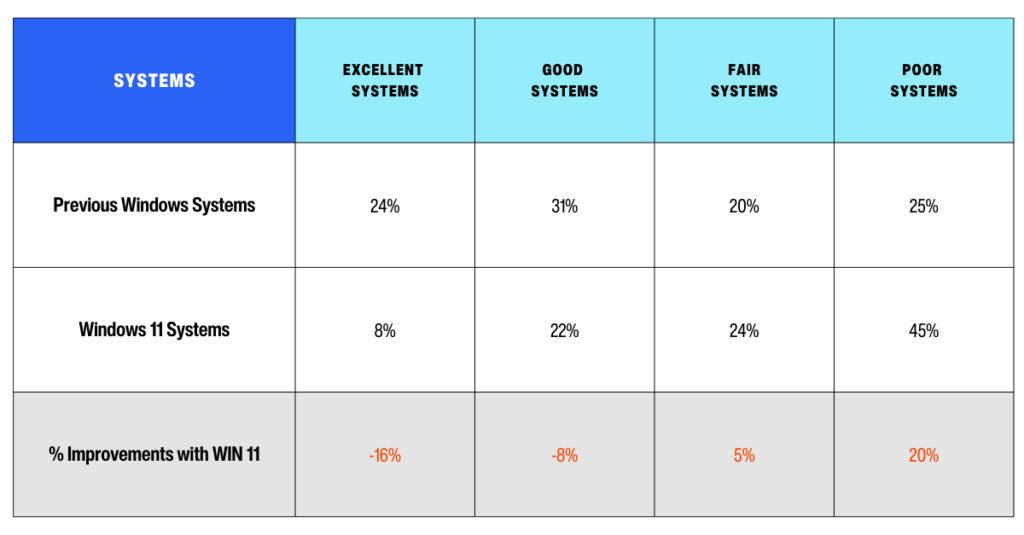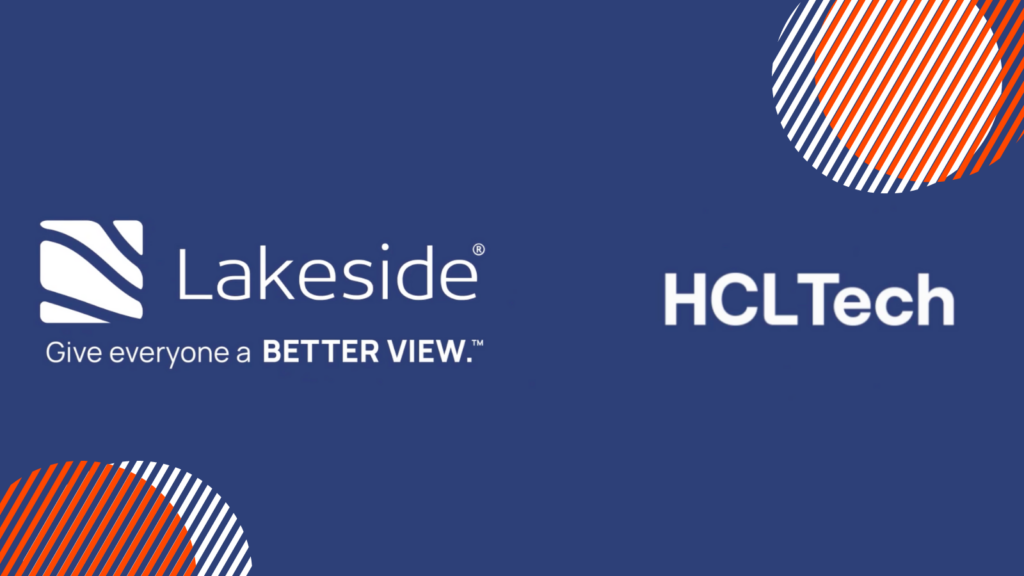Windows 10 Pro vs. Enterprise: What is the difference? Or is it time to upgrade?

Over four years have passed since the release of Windows 10. Windows 10 support will officially end in October 2025. However, according to Lakeside’s anonymized global endpoint data, only about 12% of Windows endpoint devices have been upgraded to Windows 11. And 88% of Windows endpoint devices are still on Windows 10. If your organization is one of the majority still on Windows 10, we will break down the differences between two business-oriented editions: Windows 10 Pro and Windows 10 Enterprise.
And if you’re already considering migrating to Windows 11, check out how to simplify your Windows 11 migration using data.
Windows 10 Pro vs. Enterprise
One major difference between the editions is licensing. While Windows 10 Pro can come preinstalled or through an OEM, Windows 10 Enterprise requires the purchase of a volume-licensing agreement. There are also two distinct license editions with Enterprise: Windows 10 Enterprise E3 and Windows 10 Enterprise E5. As the chart below shows, E5 offers comparatively more security features than E3. You can find more information on how these editions compare on Microsoft’s website (https://www.microsoft.com/en-us/windowsforbusiness/compare).
Management and Deployment
| Windows 10 Pro | Windows 10 Enterprise E3 | Windows 10 Enterprise E5 | |
|---|---|---|---|
| MDM (Mobile Device Management) | ✓ | ✓ | ✓ |
| AAD (Azure Active Directory) Join | ✓ | ✓ | ✓ |
| Domain Join | ✓ | ✓ | ✓ |
| MAM (Mobile Application Management) | ✓ | ✓ | ✓ |
| Shared PC Mode | ✓ | ✓ | ✓ |
| Microsoft Store for Business | ✓ | ✓ | ✓ |
| Windows Hello Management | ✓ | ✓ | ✓ |
| Kiosk Mode | ✓ | ✓ | ✓ |
| Windows Store Access Management | ✓ | ✓ | |
| CEM (Customer Experience Management) | ✓ | ✓ | |
| Cortana Management | ✓ | ✓ | |
| Microsoft Dynamic Management | ✓ | ✓ | |
| App-V (Microsoft Application Virtualization) | ✓ | ✓ | |
| UE-V (Microsoft User Environment Virtualization) | ✓ | ✓ |
Security and Identity Information
| Windows 10 Pro | Windows 10 Enterprise E3 | Windows 10 Enterprise E5 | |
|---|---|---|---|
| Conditional Access | ✓ | ✓ | ✓ |
| Windows Hello | ✓ | ✓ | ✓ |
| BitLocker and BitLocker To GO | ✓ | ✓ | ✓ |
| Windows Information Protection | ✓ | ✓ | ✓ |
| Direct Access | ✓ | ✓ | |
| Direct Guard | ✓ | ✓ | |
| Credential Guard | ✓ | ✓ | |
| Windows Defender Threat Protection | ✓ |
Analysis and Service Support
| Windows 10 Pro | Windows 10 Enterprise E3 | Windows 10 Enterprise E5 | |
|---|---|---|---|
| Windows Analytics | ✓ | ✓ | ✓ |
| Windows Update for Business | ✓ | ✓ | ✓ |
Windows Basic Features
| Windows 10 Pro | Windows 10 Enterprise E3 | Windows 10 Enterprise E5 | |
|---|---|---|---|
| Remote Desktop | ✓ | ✓ | ✓ |
| Windows To GO | ✓ | ✓ | |
| BranchCache | ✓ | ✓ | |
| Microsoft Desktop Optimization Pack | ✓ | ✓ |
Feature Overview
To understand the above charts a bit better, let’s overview some of these key features.
MDM (Mobile Device Management)
In today’s increasingly mobile business environments, improper use of mobile devices often leads to costly security incidents. Central management of enterprise mobile devices is crucial in subverting these security incidents. MDM is able to monitor all enterprise mobile devices at once, analyze usage data for individual users, and apply appropriate security policies.
Shared PC Mode
This feature allows for the configuration of shared environments for multiple clients.
Microsoft Store for Business
A private store for organizations to manage application configuration, distribution, and creation.
Windows Hello
Offers password-less sign-in using biometric authentication, including facial, retinal, and fingerprint recognition. This feature has become increasingly important as cases of unauthorized third-party use of devices continue to rise.
Cortana
The virtual assistant loaded in Windows 10. Compatible with multiple languages, Cortana uses voice commands to assist in daily business tasks, including function calls and web searches.
AppLocker
Utilizes unique identities of files to create rules that permit or deny the running of select applications. These rules can be specified at the group or user level. This feature is vital in restricting access to important files and applications and improving security.
App-V (Microsoft Application Virtualization)
Allows for the virtualization of application execution environments. Separating the application environment from the client operating system greatly improves security and management efficiency.
UE-V (Microsoft User Environment Virtualization)
Captures, saves, and manages Windows 10 OS and application settings.
Direct Access
Allows for remote access to virtual environments.
Windows Information Protection
Prevents data leaks via email, etc. and improves security. This feature helps to maintain corporate confidentiality, as data leaks via emails sent in error are exceedingly common.
Credential Guard
Allows for virtualization-based security where access is granted to only privileged systems.
Remote Desktop
Allows users of one Windows 10 device to connect to another Windows 10 device on the same network or internet connection.
Windows To GO
Allows users to create an imaged version of the corporate Windows 10 environment on a USB flash drive and run it from their personal Windows 10-compatible device.
BranchCache
Allows for access to content on remote servers for branch office workers, reducing WAN bandwidth usage and improving application response time.
Microsoft Desktop Optimization Pack
A suite of functions that allow for application virtualization, group policy management, reduction of downtime, and monitoring of rule compliance.
Is it time to upgrade to Windows 11?
With the clock ticking toward the end of support for Windows 10, your organization may be considering Windows 10 vs. Windows 11 instead of just Windows 10 Pro vs Enterprise. If that’s the case, Lakeside has compared the performance of Windows 11 against previous Windows systems. Lakeside CTO share an in-depth LinkedIn article on the topic recently.
The Lakeside SysTrack platform is installed on millions of devices across the globe. In addition to providing a platform for these organizations to resolve and prevent IT issues, and optimize their application and hardware at the organization, Lakeside gathers anonymized community telemetry data used to help provide benchmark data for our customers in their industries.
We classify systems into Excellent, Good, Fair, and Poor in terms of performance. The performance data is based off a variety of categories of data including, but not limited to, CPU Usage, Disk Usage, Faults, Network Latency, Memory Usage, and Startup Time.

Digging deeper, the two attributes that seemed to contribute the most are:
- CPU: 5% worse performance overall
- Memory: 7% worse performance overall
These metrics clearly have a significant impact on the employee’s experience on the device and could mean new computers are in order, or maybe just some extra memory just need to be ordered for some of the devices.
However, the switch to Windows 11 doesn’t necessarily mean you need to buy new hardware before upgrading systems. These two factors performed better on Windows 11 than previous Windows systems:
- Disk: 7% improvement
- Latency: 7% improvement
For each one of these metrics above, CPU, Memory, Disk, and Latency – these are only a handful of measurements used to determine the overall performance. And each one of these is made up of multiple metrics. For example – there are many things impacting performance of the drive from transfer time to queue length.
How to migrate from Windows 10 to Windows 11?
If you’re ready to start the migration from Windows 10 Pro or Enterprise to Windows 11 Pro or Enterprise, the first step is an assessment of your IT environment.
With a Windows 11 migration, the roll out to legacy hardware can present challenges for IT. In addition to the technical requirements, IT must also consider employee experience, application incompatibility, or degradations in performance that can impact downtime and overall productivity.
Lakeside Software collects and analyzes more endpoint data than anyone else in the industry. With better data, you can see better results – and that means a more seamless Windows 11 rollout.
In fact, Lakesides’ Windows 11 Migration DEX pack, one of many key solutions in the Lakeside DEX Library, is designed to assist with your journey to Windows 11. SysTrack can help you determine hardware and application readiness, identify actions to take to get your estate ready, assess Windows 11 performance and monitor the progress of the rollout.
This blog was originally published on November 14, 2019 and was updated on May 16, 2024 to reflect the most recent data on Windows OS performance .
Ready to get the industry’s best data from your endpoints to see which Windows OS is best for your organization?
See for yourself how Lakeside can help.
Subscribe to the Lakeside Newsletter
Receive platform tips, release updates, news and more



